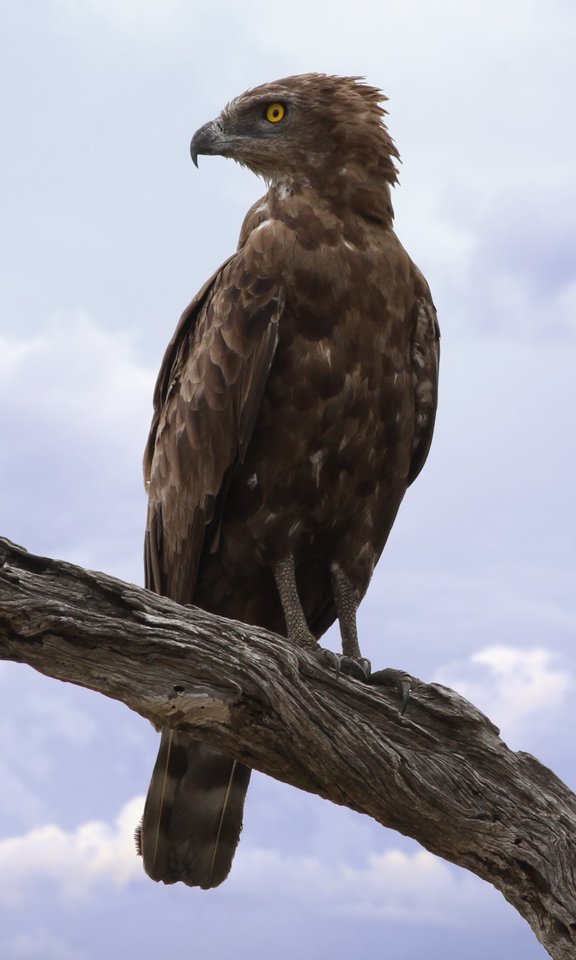Summary
Brown Snake Eagles are a species of large raptor found in Africa. They primarily feed on snakes, including venomous ones, and have natural protection against bites with thick-skinned legs. While they are known to hunt a variety of prey, there is no evidence that they regularly eat frogs. Their diet consists mainly of snakes, which they are well-equipped to catch and consume.
Do Brown Snake Eagles Eat Frogs?
 Image source: Brown snake eagle By Derek Keats
Image source: Brown snake eagle By Derek Keats
No, brown snake eagles do not typically eat frogs. Their primary prey consists of snakes, including venomous species, which they are well-adapted to hunt and consume.
Brown snake eagles have several physical adaptations that make them well-suited for hunting snakes. They have thick, scaly skin on their legs that protects them from snake bites. They also have a powerful beak and talons that allow them to crush the heads of their prey, neutralizing the threat of venom.
These eagles spend a significant amount of time perched in tall trees, scanning the ground for movement. When they spot a snake, they swoop down and catch it, rarely or never eating their prey in flight. They are known to take snakes up to 2.8 meters (9.2 feet) in length.
While brown snake eagles may occasionally opportunistically catch and consume small frogs or other amphibians, their diet is primarily focused on snakes. They are specialized predators that have evolved to excel at hunting and consuming this type of prey.
Physical Characteristics of Brown Snake Eagles
Brown snake eagles are a medium-sized species of eagle, with the following key physical characteristics:
- Total length: 66 to 78 cm (26 to 31 inches)
- Wingspan: 160 to 185 cm (5 feet 3 inches to 6 feet 1 inch)
- Weight: 1.5 to 2.5 kg (3.3 to 5.5 pounds), with an average of around 2.05 kg (4.5 pounds)
- Large head and bare legs, which help distinguish them from other brownish medium-sized eagles in Africa
- Thick, scaly skin on their legs to protect against snake bites
These physical features, along with their hunting behavior and prey preferences, make brown snake eagles well-adapted to their primary role as snake hunters in their African habitats.
Hunting Behavior and Prey Preferences
Brown snake eagles are solitary hunters that spend a significant amount of time perched in tall or exposed trees, waiting for prey to pass by. When they spot a snake, they swoop down and catch it on the ground, rarely or never eating their prey in flight.
These eagles are known to take a variety of snake species, including venomous ones. They are capable of hunting and consuming snakes up to 2.8 meters (9.2 feet) in length. To neutralize the threat of venom, they crush the head of their prey before consuming it.
In addition to snakes, brown snake eagles may occasionally take other small prey, such as small mammals, birds, or even small frogs or other amphibians. However, snakes make up the vast majority of their diet, and they are highly specialized predators when it comes to hunting and consuming this type of prey.
Breeding and Nesting Behavior
Brown snake eagles have a prolonged breeding cycle and typically raise a single eaglet per breeding season. Their breeding displays consist of dives and soars, and are usually performed by only one bird.
Pairs of brown snake eagles may have fairly large territories, up to 200 square kilometers (77 square miles) in size. They build stick nests that are 60-70 cm (24-28 inches) wide and 15-30 cm (6-12 inches) deep, typically placing them 3.5-12 meters (11.5-39 feet) above the ground. Alternatively, they may use the nest of another bird species.
The female brown snake eagle incubates a single egg for 48-53 days. Newly-hatched chicks are snow white and take 96-113 days to fledge, becoming fully independent of their parents two weeks to one month after fledging.
Conservation Status and Threats
Brown snake eagles are not considered threatened in southern Africa, although their numbers are higher in protected areas, indicating some habitat destruction and human disturbance in other areas.
Overall, the population of brown snake eagles appears to be stable, and they are currently listed as Least Concern by the International Union for Conservation of Nature (IUCN).
However, like many raptor species, they may face threats from habitat loss, human disturbance, and the use of pesticides and other chemicals that can accumulate in their prey and impact their health and reproduction.
Conclusion
In summary, brown snake eagles are specialized predators that primarily feed on snakes, including venomous species. They have evolved physical adaptations, such as thick, scaly legs, that allow them to safely hunt and consume their preferred prey. While they may occasionally take small frogs or other prey, snakes make up the vast majority of their diet. Brown snake eagles play an important role in their African ecosystems as effective snake hunters and help to maintain a balance in the populations of these reptiles.

